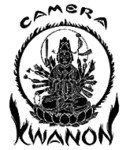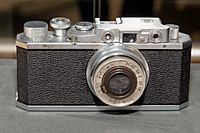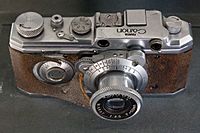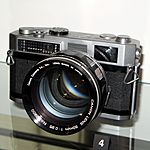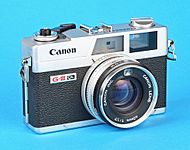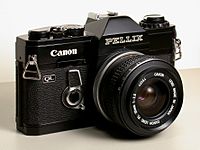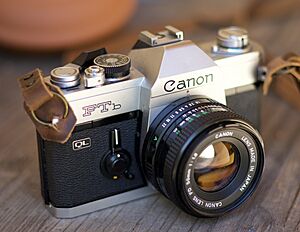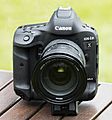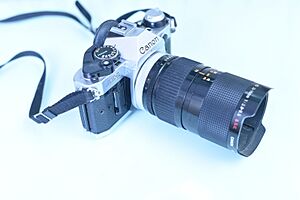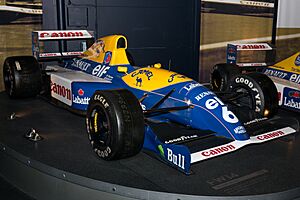Canon Inc. facts for kids

Logo since 1956
|
|
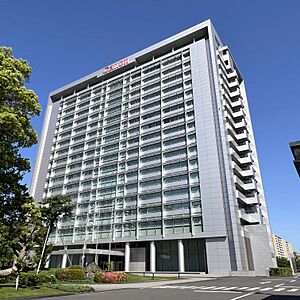
Headquarters in Ōta, Tokyo
|
|
|
Native name
|
キヤノン株式会社
|
|---|---|
|
Romanized name
|
Kyanon kabushiki gaisha |
|
Formerly
|
Precision Optical Industry Co. Ltd. (1933–1947) Canon Camera Co., Inc (1947–1969) |
| Public | |
| Traded as |
|
| Industry | Electronics |
| Founded | 10 August 1937 (as Precision Optical Industry Co. Ltd. [精機光學研究所, Seikikōgaku kenkyūsho]) Tokyo, Japan |
| Founder |
|
| Headquarters | Shimomaruko,
,
Japan
|
|
Area served
|
Worldwide |
|
Key people
|
Fujio Mitarai (chairman & CEO) |
| Products |
|
| Revenue | |
|
Operating income
|
|
| Total assets | |
| Total equity | |
|
Number of employees
|
184,034 (2021) |
| Divisions | Office Business Unit, Consumer Business Unit, Industry and Others Business Unit |
| Subsidiaries |
|
Canon Inc. is a big Japanese company based in Ōta, Tokyo. It makes many different products, especially those related to optics and imaging. This includes lenses, cameras, medical equipment, scanners, and printers. They also make equipment for creating computer chips.
Canon is listed on the Tokyo Stock Exchange. It is a major part of important Japanese stock indexes like TOPIX Core 30 and Nikkei 225.
Contents
What's in a Name?
The company first started with a different name: Precision Optical Laboratory. In 1934, they created a camera prototype called the Kwanon. This was Japan's very first 35mm camera with a special shutter.
In 1947, the company changed its name to Canon Camera Co., Inc.. Later, in 1969, it became simply Canon Inc.. The name "Canon" comes from a Buddhist figure called Kannon.
Canon's Journey Through Time
Early Years (1933–1970)
Canon began in 1933 as the Precision Optical Instruments Laboratory in Japan. It was founded by Takeshi Mitarai, Goro Yoshida, Saburo Uchida, and Takeo Maeda. In 1937, it officially became a company called Precision Optical Instruments, Co., Ltd.
In the beginning, Canon didn't make its own camera lenses. Their first cameras used lenses from another company, Nippon Kogaku K.K., which later became Nikon. Between 1933 and 1936, they developed 'The Kwanon' camera. This was a copy of the Leica design and Japan's first 35mm camera with a focal-plane shutter.
Canon also made Japan's first indirect X-ray camera in 1940. In 1958, they introduced a special zoom lens for television broadcasting. They also launched the Reflex Zoom 8 and the Canonflex cameras in 1959.
In 1961, Canon released the Canon 7 camera with a unique 50mm 1:0.95 lens. They introduced the 'Canola 130' in 1964. This was the first Japanese 10-key calculator, a big step forward in calculator design. In 1965, Canon launched the Canon Pellix. This was a SLR camera with a special mirror that allowed pictures to be taken right through it.
-
A logo from 1934 showing Bodhisattva Kwan'on
Growth and Innovation (1970–2009)
In 1971, Canon released the Canon F-1, a high-quality SLR camera, and new FD lenses. In 1976, they launched the Canon AE-1. This was the world's first camera with a tiny computer built inside.
Canon introduced their Inkjet printers using "bubble-jet" technology in 1985. In 1987, they launched the Canon Electro-Optical System (EOS). This system was named after the Greek goddess of the dawn. The Canon EOS 650 autofocus SLR camera was part of this new system. The Canon Foundation was also started in 1987.
In 1992, Canon launched the Canon EOS 5. This was the first camera with eye-controlled autofocus. They also released the PowerShot 600, their first digital camera. In 1995, Canon introduced the first SLR lens with built-in image stabilization. This helped photographers take clearer pictures.
In 1996, Canon released a small digital camera called ELPH in America and IXUS in Europe. Canon also started making digital video camcorders in 1997. In 2004, they introduced the XEED SX50 LCD projector. Canon's first high-definition camcorder came out in 2005.
In 2009, Canon offered to buy a Dutch printer company called Océ. Canon gained control of Océ by 2010 and fully owned it by the end of 2011.
Recent Developments (2010–Present)
In 2010, Canon bought Tereck Office Solutions, Inc. In 2013, Canon USA moved into a large new headquarters in Melville, New York.
Canon continued to expand by acquiring other companies. In 2014, they bought Milestone Systems, a Danish company that makes software for managing video surveillance. In 2015, Canon acquired Axis Communications, a Swedish company known for security cameras. They also bought Lifecake, a photo-sharing startup.
In 2016, Canon acquired Toshiba Medical Systems Corporation for a large sum. This helped them grow their medical equipment business. In 2017, Canon Europe acquired Kite, a printing startup.
In July 2020, Canon experienced its first-ever quarterly loss. This was due to the COVID-19 pandemic. In September 2020, Fujitsu provided Canon with a powerful supercomputer. This computer helps Canon design products without needing to build as many physical prototypes.
In October 2023, Canon introduced new manufacturing systems. They claim these systems are simpler and more affordable than other advanced technologies. These systems can create tiny circuits, similar to those found in 5 nanometer computer chips.
Canon's Products
Canon makes a wide variety of products. These include different types of cameras, like compact digital cameras and digital SLRs. They also make camcorders, lenses, and equipment for TV broadcasting.
Other products include projectors, manufacturing equipment for computer chips, printers, photocopiers, and image scanners. Canon also produces fax machines, binoculars, microscopes, and medical equipment like X-ray and CT scanners. They even make calculators and space satellites.
Digital Cameras
Canon has been making digital cameras since 1984, starting with the RC-701. They later introduced popular series like PowerShot and Digital IXUS. Canon also developed the EOS series, which includes high-end professional digital single-lens reflex cameras (DSLRs).
Because more people started using smartphones for photos, Canon's profit from compact cameras decreased in 2013.
Flash Units
Canon produces many powerful flash units for its DSLR cameras. These include models like the 270EX II, 320EX, and 430EX III-RT. They also make special macro flash units for close-up photography.
Camcorders
Canon offers a range of camcorders for capturing video.
CMOS Image Sensors
Canon designs and makes its own CMOS image sensors. These are the parts that capture light to create digital images. They have three special factories in Japan for this. In 2016, Canon, one of the world's largest image sensor makers, started selling these sensors to other companies. They focus on special areas like industrial use and space observation, not just smartphone sensors.
Canon has been at the forefront of image sensor resolution. In 2015, they showed a 250-megapixel image sensor. In 2018, they launched a 120-megapixel image sensor for businesses.
Printers
For many years, Canon was a main maker of the "print engines" inside standard laser printers. Many early Apple LaserWriter and HP LaserJet printers used Canon's print engines.
After buying the Dutch company Océ in 2010, Canon continued to develop printing systems. On January 1, 2020, Océ was officially renamed Canon Production Printing.
Canon has faced lawsuits about its all-in-one printers. Some people claimed these printers couldn't scan when the ink was low. Canon settled a lawsuit about this in 2023.
Digital Copiers
Canon's biggest business area by money earned is its multifunction copier division. They sell their imageCLASS line to regular customers and their professional imageRUNNER series to businesses. These professional copiers range from small desktop models to large digital printing machines.
Scanners
Canon makes many types of flatbed scanners, film scanners, and document scanners for homes and businesses. Some of their scanners use a special technology called LiDE. This means they can get power just from a USB port, so they don't need an extra power cord.
Calculators
Canon has produced many kinds of calculators. These include handheld, desktop, printing, and scientific calculators. One famous model was the 1964 Canola 130. It had 13 digits, which was important for Japanese banks at the time.
Projectors
Canon also makes a variety of projectors for different uses.
Presenters
Canon offers wireless presenters. These can be advanced green laser presenters with screens or simpler red laser pointers for presentations.
Virtual Reality Headsets
Canon is working on a virtual reality headset. This headset offers a very wide view. As of 2020, Canon sells high-end AR (augmented reality) headsets for businesses.
Manufacturing Equipment
Canon is a leading maker of equipment for creating computer chips and displays. Their company Canon Tokki is very important for making OLED displays. Canon is also a top maker of display photolithography equipment. While they were once a leader in semiconductor lithography, other companies like ASML have grown larger in that specific market.
Past Products
Computers
Canon released two MSX home computer models in 1983, the V-10 and the V-20. The V-20 could even get photo data from a Canon T90 camera.
Canon also sold a Canon AS100 PC. This computer used an Intel 8088 processor and could run CP/M or MS-DOS operating systems.
How Canon Works
As of 2020, Canon is divided into four main business groups:
- Office Business Unit: This group makes copying machines, digital printers, and large inkjet printers.
- Imaging System Business Unit: This group handles cameras, camcorders, lenses, scanners, and inkjet printers.
- Medical System Business Unit: This group focuses on medical equipment like X-ray machines and ultrasound scanners.
- Industry and Others Business Unit: This group makes things like computer chip manufacturing equipment and network cameras.
Canon Inc. has many smaller companies (subsidiaries) around the world. Canon's main headquarters is in Tokyo, Japan. They also have regional headquarters in places like America, Europe, and Asia.
In 2011, Canon earned a total of about US$45.6 billion. Most of this money came from the Office Business Unit. A large part of their earnings came from Europe and the Americas. Canon also invests a lot of money in research and development. In 2011, they were granted many patents in the United States, showing their focus on new inventions.
Caring for the Environment
A report by Clean Air-Cool Planet once ranked Canon highly among companies that are climate-friendly. Canon has also launched "Green Calculators" in Europe, which are partly made from recycled Canon copiers.
Canon has an environmental plan to create products that are better for the environment. They aim to use resources more efficiently and avoid activities that harm people or the planet. In 2020, Canon joined WIPO GREEN to help fight climate change.
Helping Others
In 2008, Canon gave money to help people affected by an earthquake in China. They donated to the Red Cross Society of China.
Since 2006, Canon Europe has worked with the Red Cross. They help youth projects by giving money, imaging equipment like cameras, and volunteer support.
Canon Europe has also partnered with World Press Photo for many years. This organization helps promote high standards in photography and holds a big international contest for photojournalists.
Canon Asia has sponsored competitions like Canon Photomarathon and the TV show Photo Face-Off.
Sponsorships
In 1983, Canon became the first main sponsor of the English football league, which was then called The Canon League. Canon also sponsored the Italian football club Hellas Verona FC when they won a championship in 1985.
From 1967 to 2003, Canon sponsored the Greater Hartford Open golf tournament.
In Formula One racing, Canon sponsored the Williams team from 1985 to 1993. During this time, Williams won several World Drivers Championships and World Constructors Championships. Canon also sponsored Brawn GP in the 2009 Singapore Grand Prix.
Between 1994 and 1997, they sponsored the South Sydney Rabbitohs rugby team.
See also
 In Spanish: Canon Inc. para niños
In Spanish: Canon Inc. para niños
- Canon Open
- Nikon


